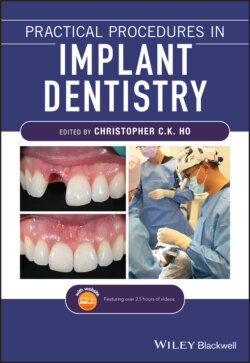Читать книгу Practical Procedures in Implant Dentistry - Группа авторов - Страница 43
5.1.1 Local Site Effects of Tooth Loss
ОглавлениеThe loss of a tooth or teeth initiates a dynamic sequence of events resulting in marked changes to the surrounding alveolar process of the jaw, largely a tooth‐dependent structure [2], while causing little change to the underlying basal bone. The gradual pattern of bone resorption in the mandible is depicted in Figure 5.2, which shows the contour changes from the dentate state (image on lower left) to advanced alveolar bone loss (image on upper right).
Figure 5.2 Resorption patterns of the mandibular edentulous ridge (note the significant reduction of the alveolar process with lesser change of the underlying basal bone).
Immediately following tooth extraction, the residual socket fills with blood and a clot is formed [3, 4]. The blood clot occupying the volume of the socket is rapidly remodelled within the first week following extraction, with granulation tissue rich in vascular structures, fibroblasts, and inflammatory cells beginning to fill the socket [3, 5]. Connective tissue begins to replace granulation tissue between the first and third weeks post‐extraction [3, 5, 6]. The epithelium then migrates across the underlying connective tissue at this time, soon closing the orifice of the extraction socket. The granulation tissue and connective tissue is gradually replaced by a primary matrix and woven bone at approximately six weeks post‐extraction, with the socket predominantly containing primary matrix and woven bone by weeks 12–24 [3, 5]. While initial tissue modelling in the extraction socket is a relatively rapid process, remodelling of woven bone into lamellar bone requires more time, with little observation of the lamellar bone being present at 12–24 weeks post‐extraction [5]. Figure 5.3 depicts how the healing process of the extraction socket evolves over time.
Figure 5.3 Progressive healing of extraction socket. BC, blood clot; GT, granulation tissue; CT, connective tissue; PM, provisional matrix; WB, woven bone.
This return to tissue homeostasis does not prevent alterations to the local hard and soft tissue contours following healing, as the resulting residual ridge architecture is diminished in both horizontal and, to a lesser degree, vertical dimensions (Figure 5.4). The clinical reduction of alveolar ridge width upon healing was found to be 3.87 mm on average, while the clinical vertical reduction was 1.67 mm [7]. The alteration of the residual ridge width is most pronounced on the buccal aspect [8, 9]. This observed pattern of resorption often results in a narrower and shorter ridge that is relocated to a more palatal or lingual position relative to its pre‐extraction condition [10]. This pattern of bone loss may have a direct influence over the subsequent positioning of any replacement teeth proposed, both for functional and aesthetic purposes.
Figure 5.4 Hard and soft tissue healing of a single tooth extraction. (a) Clinical photograph of UR4 prior to atraumatic extraction and (b) four months following extraction. (c) Radiographic image of UR4 prior to extraction, and (d) four months following extraction.
The alteration of soft tissue dimension following tooth extraction happens more rapidly than that of the hard tissue, with more than 50% of the changes observed in the first two weeks following extraction [11]. In the pre‐extraction condition, no significant correlation has been observed between soft tissue thickness and the buccal bony wall thickness under the tissue [12]. Soft tissue thickness generally tends to increase, sometimes quite substantially, following tooth extraction in subjects with the more common thin buccal bony wall phenotypes [11, 13]. This thickening of the soft tissues may mask an underlying deficient bony ridge. Conversely, subjects exhibiting thicker bony wall phenotypes do not exhibit changes in the facial soft tissue thickness from the pre‐extraction condition [11].
Changes in hard and soft tissues following extraction of a tooth may be further exacerbated by systemic factors such as smoking [14]. Local site‐specific factors include the pre‐existing condition of the tooth and surrounding tissue, the number and proximity of teeth being extracted, the number and proximity of teeth remaining, the condition of the extraction socket after tooth removal, the influence of hard and soft tissue biotype, and the use of an interim prosthesis [15].
